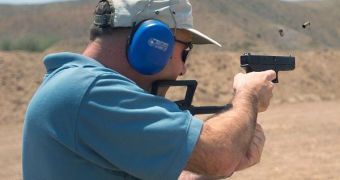Scientists from the University of Alabama in Birmingham, led by associate professor Timothy Kraft, announce the development of a new sighting system for firearms, one that they say easily surpasses the one currently used in a variety of firearms around the world. They state that their system is a significant improvement on the existing one, and that people who have had the chance to test the innovation are very happy with it. The new sights are created in a way that will allow law enforcement officials and other gun owners to minimize the time they spend on target practice, LiveScience reports.
In a regular gun, the sight is composed of a metal, square-shaped post at the front of the barrel, and a metal notch at the end. The shooter needs to learn how to align the two in such a manner that the gun barrel is oriented straight at the target. While this method has been in used since the earliest days, it can be imprecise, and takes a lot of time to get accustomed to. According to experts, the latter happens because the human brain needs to take into account a lot of different things when using the system.
“The way a traditional gunsight works is all very disconnected. In order to get a good shot off you have to visually scan the gap between the front post and rear sight on the left and equalize that to the gap on the right, then align all that with the center of the target. It is too much for the eye and brain to process,” Kraft says. He adds that his team's innovation, called opti-sight, is a lot more intuitive and readily-usable than its predecessor. It also features a post on the rear end of the barrel, but it is shaped like an incomplete triangle, with a missing tip. This means that it relies on the brain's innate ability to fill in the missing pieces by itself.
“Opti-sight makes shooting very intuitive by allowing gunsight alignment to become subconscious. This triangular shape that I've created allows the brain to visualize concentric triangles whose imaginary apexes focus the shooter's attention on the exact target bullseye,” the expert adds. Kraft himself is involved in national competitions against the best pistol shooters in the United States, and has worked close with the US Olympic pistol team on testing the opti-sight system.

 14 DAY TRIAL //
14 DAY TRIAL //